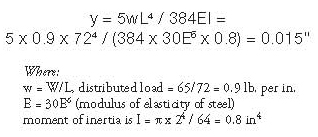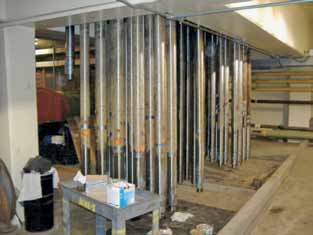First of Two Parts
Strengthening of bent shafts is a tricky and controversial process. A bent shaft can cause many pump problems—including wear of supporting bushings, leaky seals, high vibrations, overloaded bearings and a multitude of other issues.
Example
Consider a 6-foot-long, 2-inch diameter steel shaft used as a section of a vertical turbine pump, operated at 1,800 rpm. The shaft weighs approximately 65 pounds, and in a horizontal position will sag by approximately 0.015 inch:

Fortunately for a vertical turbine pump, its shaft is vertical, and therefore, no static deflection as calculated above would apply.
In fact, this is a good reason not to store slender shafts in a horizontal position.

Figure 1. Vertical turbine shafts wisely stored vertically.
In a horizontal position, given time, deflections can set-in permanent deformation. A good maintenance practice is to store slender shafts vertically, as seen in Figure 1.
A permanently bent shaft will cause centrifugal force due to eccentricity (bend). For simplicity, assuming the weight of the shaft is in the middle, centrifugal force will calculate as:

Centrifugal force can be even greater than the weight of the shaft itself, and therefore, bent shafts are not a good thing.
Correcting a Bent Shaft
Straightening shafts can be an issue either during initial manufacturing or as discovered during an inspection of the pump at repair. Specifications—such as ANSI, API, PIP and others—impose limits on shaft straightness, but generally (unless an unusually long and slender shaft).
Anything over 0.001 inch/0.002 inch is considered excessive. Manufacturing errors are unfortunately made, and machine shops routinely face a dilemma of either having to replace a shaft with a new one or strengthening a bad (bent) shaft.
Three main methods can be used to straighten a pump shaft:
- Peening method
- Heat method
- Mechanical method
In peening, shafts are “hammered” (impacted) at high spots until the shaft is literally “hammered-back” to shape. With the heat method, heat from a torch is applied (sometimes in combination with peening) to straighten it. The mechanical method uses a press that is applied to straighten the shaft to a more reasonable value, and then peening and/or heating may still be applied to fine tune it to within the allowable values.
Shaft Straightening Limitations
There are limitations, however, that determine which shafts may still be salvaged by these procedures, versus those that must be scrapped for a new shaft.
These limitations include shaft size, material and the amount of initial distortion. Since all the methods involve correcting deformations beyond the elastic limits, some of the considerations include stresses imposed, changes in metallographic structure, micro-cracking and others. A post-straightening heat treatment is often required.
Unfortunately, none of the procedures can universally solve all shaft problems, and most repair facilities apply internal experience to decide which should be used.
Because of this, many end users are reluctant to accept straightened shafts, fearing deformations will return once a pump is in operation.
Horror stories are abundant and are equally matched by success stories of large and expensive shafts straightened, avoiding the production of a new (and expensive) shaft.
Sometimes, depending on who is asked (repair shop versus OEM versus end user), different feedback on success (or lack of) of such operations will be obtained.
What do you say? Your feedback will be incorporated into a document, “Shaft Strengthening Methods and Procedures,” and published following my next Pump School session (February 26 to 26, 2012—www.pumpingmachinery.com/pump_school/pump_school.htm).
Pumps & Systems, December 2011
Click here to see a Readers Response to this article.


